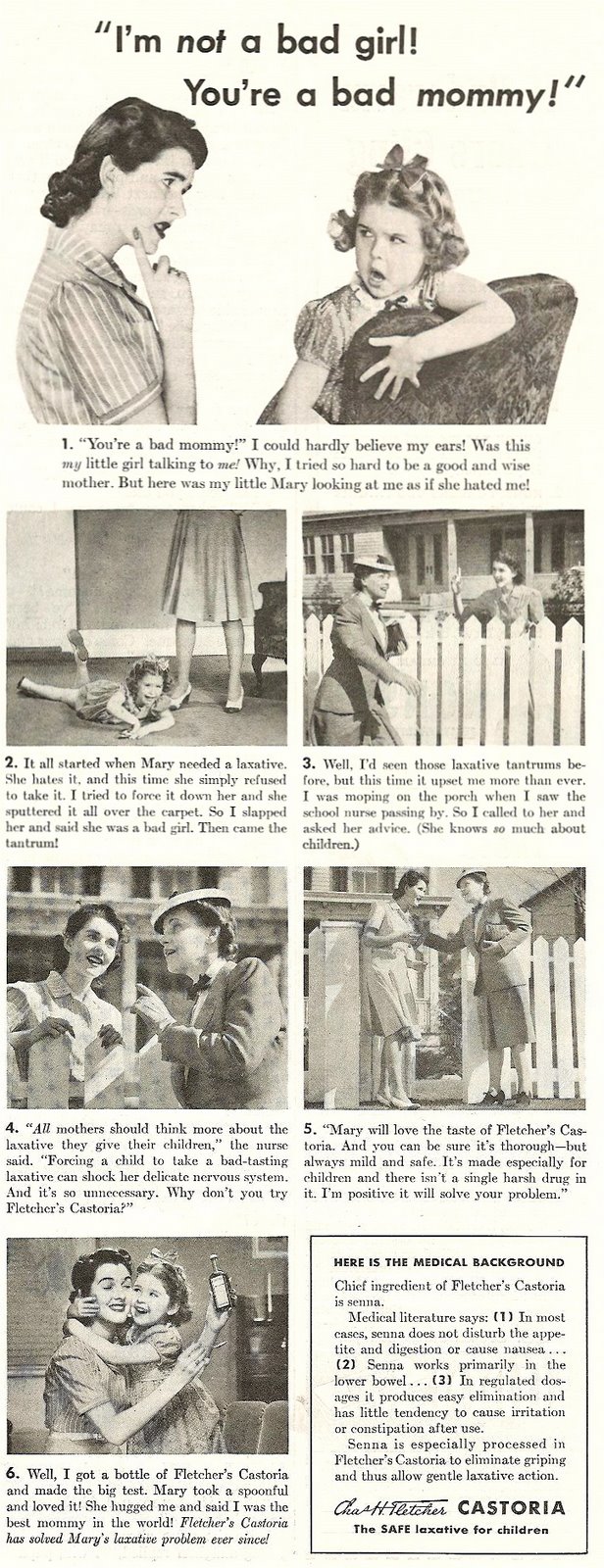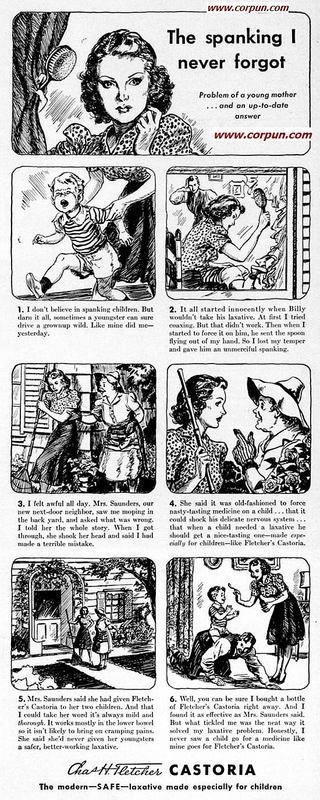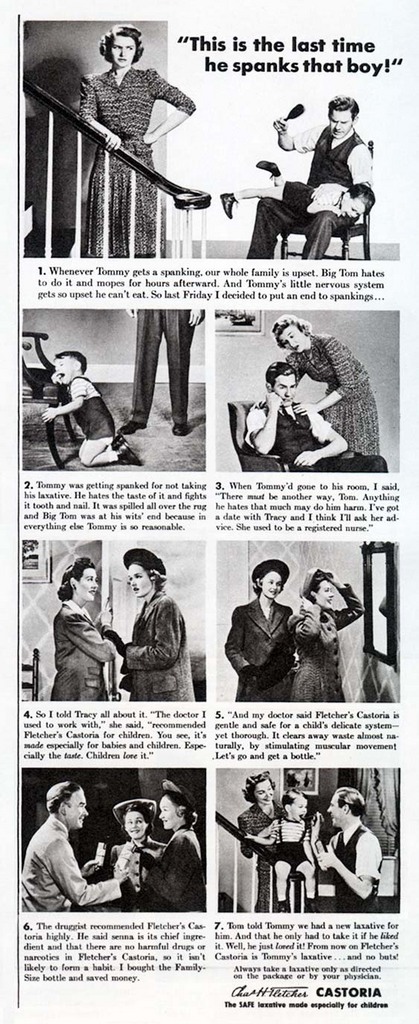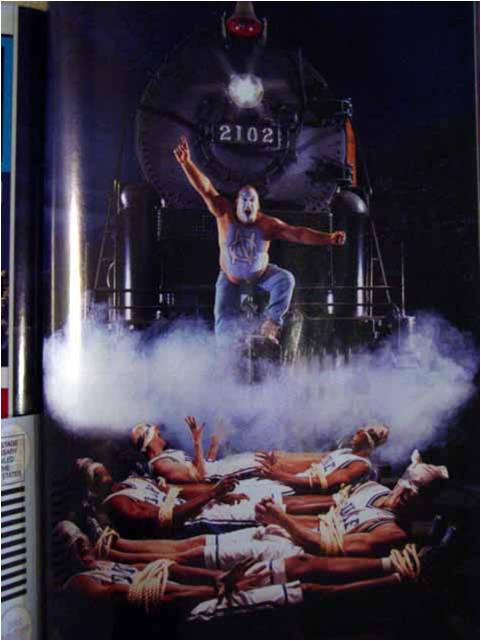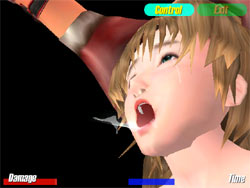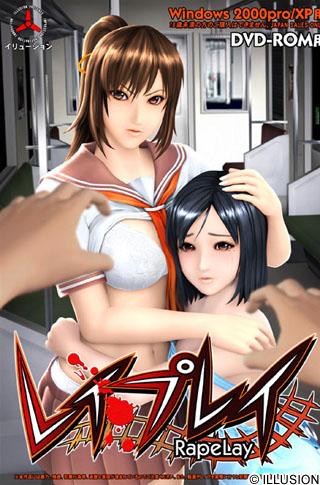
This excellent documentary documents the powerful interests behind Disney and criticizes the extent to which young American children’s childhoods are influenced by the company. The comments on the messages behind Beauty and the Beast are particularly troubling.
violence
Ben O. sent us this 1941 ad for Fletcher’s Castoria (found at I’m Learning to Share), in which mothers are warned (by a bratty kid) that they better give their children Fletcher’s laxatives or their children will hate them:
Text from section 2:
It all started when Mary needed a laxative. She hates it, and this time she simply refused to take it. I tried to force it down her and she splattered it all over the carpet. So I slapped her and said she was a bad girl. Then came the tantrum!
I’d say slapping her daughter is more of an indication of what type of mother she is than which laxatives she chooses, but whatever. Apparently the company liked to use corporal punishment in its ads; here are some more examples (both found at Corpun). In this first one, we learn that even parents who don’t believe in spanking may be driven to it if they use the wrong laxative (in section 2, she gives him an “unmerciful spanking”):
Text from sections 1 and 2:
I don’t believe in spanking children. But darn it all, sometimes a youngster can sure drive a grownup wild. Like mine did me–yesterday. It all started innocently when Billy wouldn’t take his laxative. At first I tried coaxing. But that didn’t work. Then when I started to force it on him, he sent the spoon flying out of my hand. So I lost my temper and gave him an unmerciful spanking.
From section 1:
Whenever Tommy gets a spanking, our whole family is upset. Big Tom hates to do it and mopes for hours afterward. And Tommy’s little nervous system gets so upset he can’t eat. So last Friday I decided to put an end to spankings…
Fletcher’s Castoria: the way to digestive and family harmony. Without it, you might end up slapping the kids around (though I have to say, that girl at the top would probably test to the utmost my opposition to violence).
Just a question: I’m not a parent, but I don’t hear my friends talking about giving their kids laxatives all the time, and I don’t remember being forced to take them as a kid (though I do remember us forcing a horse to drink a lot of castor oil once). Was this just a health fad at the time that people thought kids needed that has fallen out of favor? Did kids in the ’40s have some unique digestive problems we’ve, um, eliminated since then? Or do my friends’ kids go around constipated all the time because they don’t know to make them take senna laxatives?
Thanks again, Ben!
NEW! Sarah N. sent us another example of an add that implies laxatives lead to happier moms and better family lives:
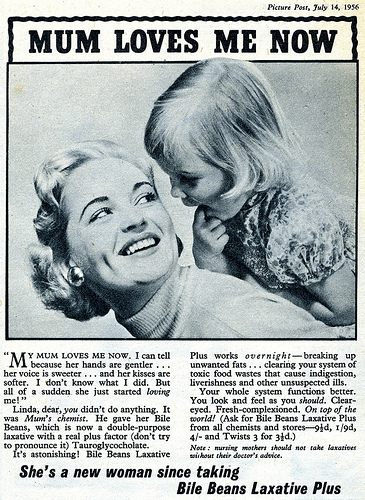
Part of the text:
“My mum loves me now. I can tell because her hands are gentler…her voice is sweeter…and her kisses are softer. I know know what I did. But all of a sudden she just started loving me!”
Linda, dear, you didn’t do anything. It was Mum’s chemist. He gave her Bile Beans…
Text: “The Hunt Is On.”
A fashion spread (note the “safari” colors”):
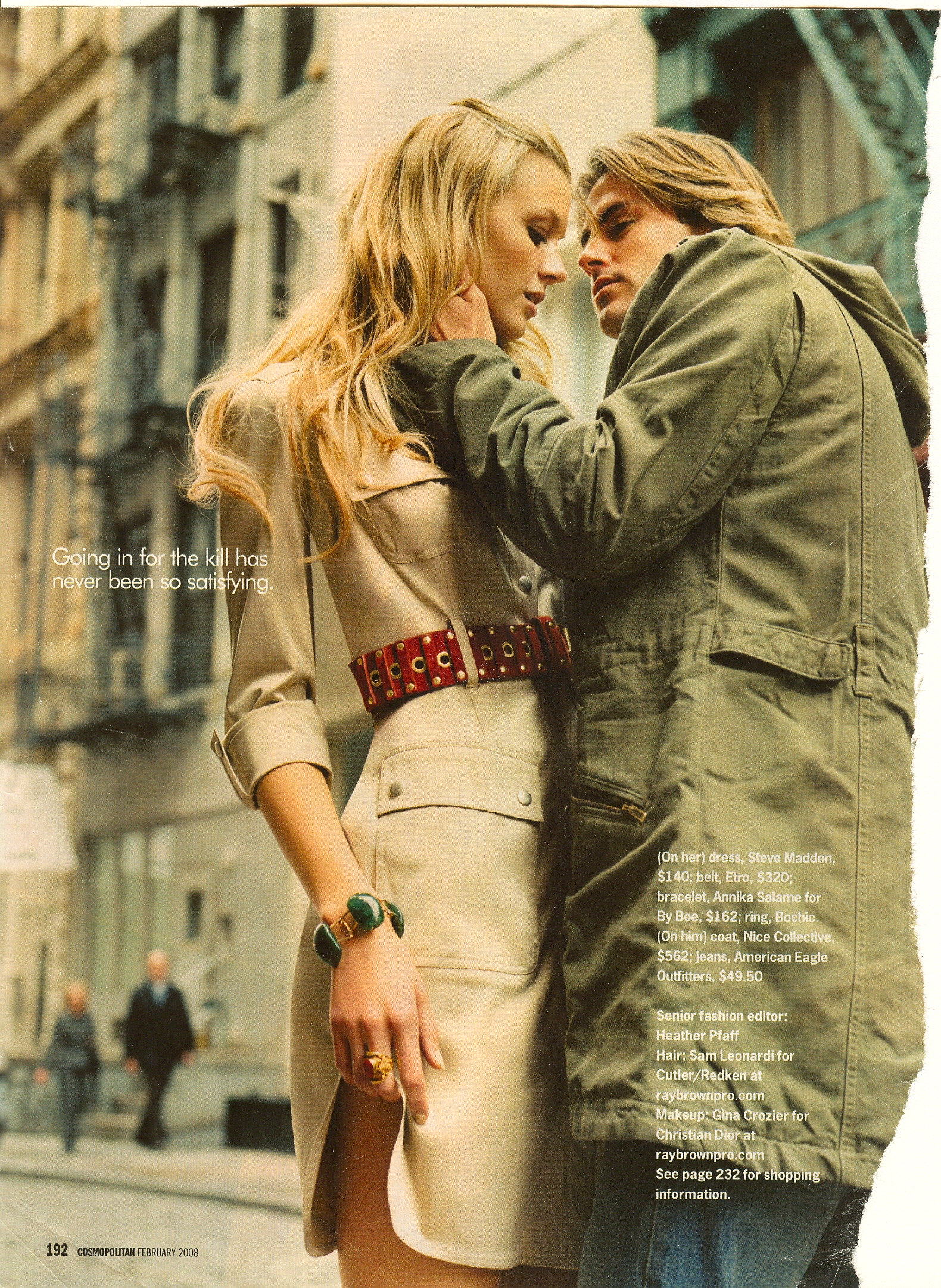
Other ads had the text: “Going in for the kill has never been so satisfying” and “Animal attraction is meant to be acted on.”
Text: “Her primal urges may be fulfilled, but he’s still hot on her trail.”
Text: “He spots his prey…”
Five-page ad for Dentyne: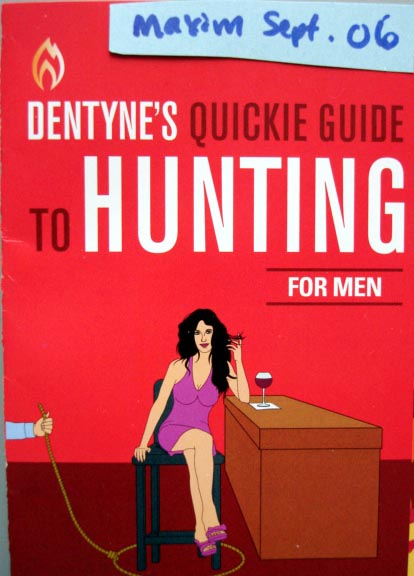
Text:
INTRODUCTION: Admit it, guys. No matter where you are, you’re thinking about it.
It’s okay. Ever since you were a cave dweller. Hunting has come naturally. But you won’t get anywhere with cave breath.
So aside from having a mouth that won’t scare her off, we’ve outlined some fundamental basics you’ll need to master when out on the hunt.
Let’s get started. Happy hunting.
THE SPECIES: First of all, you have to know what you’re hunting. Here are some common species you may encounter on your expeditions. Good luck.
THE CAREER GIRL: The one in a power suit with a cell phone attached to her ear, tends to be icy and dismissive but can be melted. Play your cards right and you will be a kept man. Habitat: Gym, high-end shoe stores, assertiveness-training classes.
THE HOT GIRL: Hot and know it. Will toy with you like a cat with a mouse (if she even notices you). Tame this one and you can write your own guide. Habitat: The market, the bus, living next door to your girlfriend.
Text:
THE EASY GIRL: Appearances vary, but the same willing soul resides within. A sure thing that can be a temporary boost to the ego. Habitat: Could be anywhere. Good chance you’ll spot her at happy hour.
THE TEASE: Easily mistaken for the easy girl, she’s anything but. Habitat: Anywhere.
THE CHATTY GIRL: You won’t recognize her until you say ‘Hi.’ Then it’s too late. To escape, fake getting a phone call and say you’ll be ‘right back.’ Habitat: Almost anywhere except a library.
THE BOHEMIAN ROCKER GIRL: Odds are she’s no musician. Just dresses like one. Look interested when she talks about all the ‘projects’ she has going on while not being an administrative assistant. Habitat: Used record stores, art museums, open mic night.
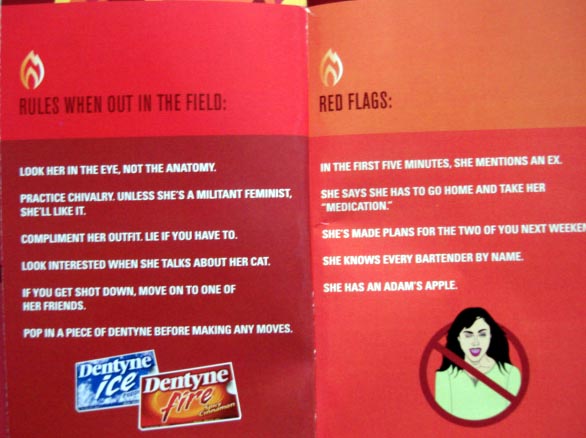
Text:
RULES WHEN OUT IN THE FIELD:
Look her in the eye, not the anatomy.
Practice chivaly. Unless she’s a militant feminist, she’ll like it.
Compliment her outfit. Lie if you have to.
Look interested when she talks about her cat.
If you get shot down, move on to one of her friends.
Pop in a piece of Dentyne before making any moves.
RED FLAGS:
In the first five minutes, she mentions an ex.
She says she has to go home and take her ‘medication.’
She’s made plans for the two of you next weekend.
She knows every bartender by name.
She has an adam’s apple.
Text:
THE ARSENAL:
Money (it never hurts).
Your own place. Living above mom and dad’s garage doesn’t count.
Perseverance, it’s tough out there.
Plenty of Dentyne gum.
These all remind me of an unfortunate Target billboard.
Thanks to my students who have brought these in over the years!
Lisa Wade, PhD is an Associate Professor at Tulane University. She is the author of American Hookup, a book about college sexual culture; a textbook about gender; and a forthcoming introductory text: Terrible Magnificent Sociology. You can follow her on Twitter and Instagram.
Lisa Wade, PhD is an Associate Professor at Tulane University. She is the author of American Hookup, a book about college sexual culture; a textbook about gender; and a forthcoming introductory text: Terrible Magnificent Sociology. You can follow her on Twitter and Instagram.
Burk brought my attention to the video game Battle Raper. I found a Battle Raper website, but it was all in Japanese, and I couldn’t find an English version, so I will provide you a short description from Wikipedia:
Battle Raper is a 3D fighting game in which the objective is to strip, grope, and sometimes actively rape the female characters, including a special move by the boss character and only male fighter where the female opponent is forced to perform fellatio as the camera zooms in. Like in most Hentai games, however, the penis is rendered invisible or transparent. There is also a feature in the game which allows the player to have sex with the female characters.
Here is a screenshot (found at Something Awful) of a female character crying because she is being forced to perform oral sex on the male character:
You can also damage your opponent by molesting their breasts or crotch. Once you win the game playing each of the different characters, you open a function where you can look at all the rape scenes. Here’s a shot of a female character’s face as she’s being raped:
Apparently in Battle Raper 2, they took out the rape function.
A simple description of this game will have to do, because I just can’t bring myself to write any commentary about it.
UPDATE: For the record, I’m not saying a) the Japanese are more sexist than other cultures, b) this game is (or isn’t) representative of video games in general or hentai games in particular, c) that video games lead to any particular behaviors or make people act violently, or d) that people shouldn’t be able to play these games in the privacy of their own homes.
It was sent to me as a possible post, I thought it was interesting, and I thought the discussion by some gamers I found on different websites was also fascinating: lots of people saying “Oh, I play violent stuff, but this was unacceptable even for me!” and saying how they put rape in a different category than any other type of violence, so these types of games are worse than “regular” violent video games. I thought of it as a case that might be useful for discussions of cultural representations of rape, and particularly how we often treat rape as a “special” type of crime that is somehow worse than any other type, possibly even murder. Why we do that, and what it means (particularly, how does it impact the stigmatizing of rape victims, who are often treated as though they are permanently broken and defiled?), are sociologically interesting questions.
NEW (Apr. ’10)! Dmitriy T.M., Beth W., Tom M., Abby D., and Jillian Y. all sent in another game with the same theme. The narrative for this one, called Rapelay, is as follows:
The player plays as a chikan (a perverted man who frequently fondles women) in crowded subway trains. A young woman named Aoi has the player arrested for molesting her. Afterwards, the player plans to exact revenge by molesting and raping her entire family (source).
This is the cover:
A still from the game:
Most media coverage won’t offer images, saying that they are too graphic to show.
This Australian commercial for Toyota Corolla (found here) includes a homogenous, racialized out-group. More after the video:
[youtube]http://www.youtube.com/watch?v=Ckb-wUHj9WU[/youtube]
The term “out-group homogeneity” refers to the way in which members of an in-group tend to overestimate the extent to which members of an out-group are all alike. I suppose we don’t know what good kitty’s friends look like (do they all look exactly like him?), but we certainly have the presentation of an out-group that is both categorically different from good kitty and homogeneously so.
I would also like to suggest that that out-group is racialized. They didn’t use just any kind of cat to represent bad kitties, but a dark-colored cat. (If I know my cats, the bad “guys” in this video are Russian Blues.)
Between 1864 and 1923, there were 14 forced county-wide expulsions of African Americans (alongside many town expulsions). The figure below shows the percentage of African Americans living in Vermillion County, Indiana in the years before and after an expulsion.
Click here for an interactive website with information about these expulsions made by the Austin American Statesman newspaper. See also our post about “Sundown Towns,” which kept Blacks out by making it illegal for them to be there after sundown.
The trivialization of domestic violence + Obama is going to destroy America + the stereotype of black men as violent. Sigh. Buy it here.
Thanks to Tim C. for the tip!
Ben O. sent us this 1941 ad for Fletcher’s Castoria (found at I’m Learning to Share), in which mothers are warned (by a bratty kid) that they better give their children Fletcher’s laxatives or their children will hate them:
Text from section 2:
It all started when Mary needed a laxative. She hates it, and this time she simply refused to take it. I tried to force it down her and she splattered it all over the carpet. So I slapped her and said she was a bad girl. Then came the tantrum!
I’d say slapping her daughter is more of an indication of what type of mother she is than which laxatives she chooses, but whatever. Apparently the company liked to use corporal punishment in its ads; here are some more examples (both found at Corpun). In this first one, we learn that even parents who don’t believe in spanking may be driven to it if they use the wrong laxative (in section 2, she gives him an “unmerciful spanking”):
Text from sections 1 and 2:
I don’t believe in spanking children. But darn it all, sometimes a youngster can sure drive a grownup wild. Like mine did me–yesterday. It all started innocently when Billy wouldn’t take his laxative. At first I tried coaxing. But that didn’t work. Then when I started to force it on him, he sent the spoon flying out of my hand. So I lost my temper and gave him an unmerciful spanking.
From section 1:
Whenever Tommy gets a spanking, our whole family is upset. Big Tom hates to do it and mopes for hours afterward. And Tommy’s little nervous system gets so upset he can’t eat. So last Friday I decided to put an end to spankings…
Fletcher’s Castoria: the way to digestive and family harmony. Without it, you might end up slapping the kids around (though I have to say, that girl at the top would probably test to the utmost my opposition to violence).
Just a question: I’m not a parent, but I don’t hear my friends talking about giving their kids laxatives all the time, and I don’t remember being forced to take them as a kid (though I do remember us forcing a horse to drink a lot of castor oil once). Was this just a health fad at the time that people thought kids needed that has fallen out of favor? Did kids in the ’40s have some unique digestive problems we’ve, um, eliminated since then? Or do my friends’ kids go around constipated all the time because they don’t know to make them take senna laxatives?
Thanks again, Ben!
NEW! Sarah N. sent us another example of an add that implies laxatives lead to happier moms and better family lives:

Part of the text:
“My mum loves me now. I can tell because her hands are gentler…her voice is sweeter…and her kisses are softer. I know know what I did. But all of a sudden she just started loving me!”
Linda, dear, you didn’t do anything. It was Mum’s chemist. He gave her Bile Beans…
Text: “The Hunt Is On.”
A fashion spread (note the “safari” colors”):

Other ads had the text: “Going in for the kill has never been so satisfying” and “Animal attraction is meant to be acted on.”
Text: “Her primal urges may be fulfilled, but he’s still hot on her trail.”
Text: “He spots his prey…”
Five-page ad for Dentyne:
Text:
INTRODUCTION: Admit it, guys. No matter where you are, you’re thinking about it.
It’s okay. Ever since you were a cave dweller. Hunting has come naturally. But you won’t get anywhere with cave breath.
So aside from having a mouth that won’t scare her off, we’ve outlined some fundamental basics you’ll need to master when out on the hunt.
Let’s get started. Happy hunting.
THE SPECIES: First of all, you have to know what you’re hunting. Here are some common species you may encounter on your expeditions. Good luck.
THE CAREER GIRL: The one in a power suit with a cell phone attached to her ear, tends to be icy and dismissive but can be melted. Play your cards right and you will be a kept man. Habitat: Gym, high-end shoe stores, assertiveness-training classes.
THE HOT GIRL: Hot and know it. Will toy with you like a cat with a mouse (if she even notices you). Tame this one and you can write your own guide. Habitat: The market, the bus, living next door to your girlfriend.
Text:
THE EASY GIRL: Appearances vary, but the same willing soul resides within. A sure thing that can be a temporary boost to the ego. Habitat: Could be anywhere. Good chance you’ll spot her at happy hour.
THE TEASE: Easily mistaken for the easy girl, she’s anything but. Habitat: Anywhere.
THE CHATTY GIRL: You won’t recognize her until you say ‘Hi.’ Then it’s too late. To escape, fake getting a phone call and say you’ll be ‘right back.’ Habitat: Almost anywhere except a library.
THE BOHEMIAN ROCKER GIRL: Odds are she’s no musician. Just dresses like one. Look interested when she talks about all the ‘projects’ she has going on while not being an administrative assistant. Habitat: Used record stores, art museums, open mic night.

Text:
RULES WHEN OUT IN THE FIELD:
Look her in the eye, not the anatomy.
Practice chivaly. Unless she’s a militant feminist, she’ll like it.
Compliment her outfit. Lie if you have to.
Look interested when she talks about her cat.
If you get shot down, move on to one of her friends.
Pop in a piece of Dentyne before making any moves.
RED FLAGS:
In the first five minutes, she mentions an ex.
She says she has to go home and take her ‘medication.’
She’s made plans for the two of you next weekend.
She knows every bartender by name.
She has an adam’s apple.
Text:
THE ARSENAL:
Money (it never hurts).
Your own place. Living above mom and dad’s garage doesn’t count.
Perseverance, it’s tough out there.
Plenty of Dentyne gum.
These all remind me of an unfortunate Target billboard.
Thanks to my students who have brought these in over the years!
Lisa Wade, PhD is an Associate Professor at Tulane University. She is the author of American Hookup, a book about college sexual culture; a textbook about gender; and a forthcoming introductory text: Terrible Magnificent Sociology. You can follow her on Twitter and Instagram.
Lisa Wade, PhD is an Associate Professor at Tulane University. She is the author of American Hookup, a book about college sexual culture; a textbook about gender; and a forthcoming introductory text: Terrible Magnificent Sociology. You can follow her on Twitter and Instagram.
Burk brought my attention to the video game Battle Raper. I found a Battle Raper website, but it was all in Japanese, and I couldn’t find an English version, so I will provide you a short description from Wikipedia:
Battle Raper is a 3D fighting game in which the objective is to strip, grope, and sometimes actively rape the female characters, including a special move by the boss character and only male fighter where the female opponent is forced to perform fellatio as the camera zooms in. Like in most Hentai games, however, the penis is rendered invisible or transparent. There is also a feature in the game which allows the player to have sex with the female characters.
Here is a screenshot (found at Something Awful) of a female character crying because she is being forced to perform oral sex on the male character:
You can also damage your opponent by molesting their breasts or crotch. Once you win the game playing each of the different characters, you open a function where you can look at all the rape scenes. Here’s a shot of a female character’s face as she’s being raped:
Apparently in Battle Raper 2, they took out the rape function.
A simple description of this game will have to do, because I just can’t bring myself to write any commentary about it.
UPDATE: For the record, I’m not saying a) the Japanese are more sexist than other cultures, b) this game is (or isn’t) representative of video games in general or hentai games in particular, c) that video games lead to any particular behaviors or make people act violently, or d) that people shouldn’t be able to play these games in the privacy of their own homes.
It was sent to me as a possible post, I thought it was interesting, and I thought the discussion by some gamers I found on different websites was also fascinating: lots of people saying “Oh, I play violent stuff, but this was unacceptable even for me!” and saying how they put rape in a different category than any other type of violence, so these types of games are worse than “regular” violent video games. I thought of it as a case that might be useful for discussions of cultural representations of rape, and particularly how we often treat rape as a “special” type of crime that is somehow worse than any other type, possibly even murder. Why we do that, and what it means (particularly, how does it impact the stigmatizing of rape victims, who are often treated as though they are permanently broken and defiled?), are sociologically interesting questions.
NEW (Apr. ’10)! Dmitriy T.M., Beth W., Tom M., Abby D., and Jillian Y. all sent in another game with the same theme. The narrative for this one, called Rapelay, is as follows:
The player plays as a chikan (a perverted man who frequently fondles women) in crowded subway trains. A young woman named Aoi has the player arrested for molesting her. Afterwards, the player plans to exact revenge by molesting and raping her entire family (source).
This is the cover:
A still from the game:
Most media coverage won’t offer images, saying that they are too graphic to show.
This Australian commercial for Toyota Corolla (found here) includes a homogenous, racialized out-group. More after the video:
[youtube]http://www.youtube.com/watch?v=Ckb-wUHj9WU[/youtube]
The term “out-group homogeneity” refers to the way in which members of an in-group tend to overestimate the extent to which members of an out-group are all alike. I suppose we don’t know what good kitty’s friends look like (do they all look exactly like him?), but we certainly have the presentation of an out-group that is both categorically different from good kitty and homogeneously so.
I would also like to suggest that that out-group is racialized. They didn’t use just any kind of cat to represent bad kitties, but a dark-colored cat. (If I know my cats, the bad “guys” in this video are Russian Blues.)
Between 1864 and 1923, there were 14 forced county-wide expulsions of African Americans (alongside many town expulsions). The figure below shows the percentage of African Americans living in Vermillion County, Indiana in the years before and after an expulsion.
Click here for an interactive website with information about these expulsions made by the Austin American Statesman newspaper. See also our post about “Sundown Towns,” which kept Blacks out by making it illegal for them to be there after sundown.
The trivialization of domestic violence + Obama is going to destroy America + the stereotype of black men as violent. Sigh. Buy it here.
Thanks to Tim C. for the tip!

